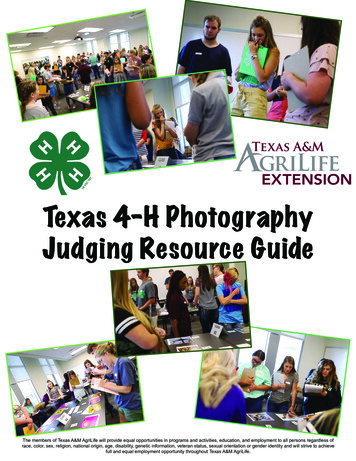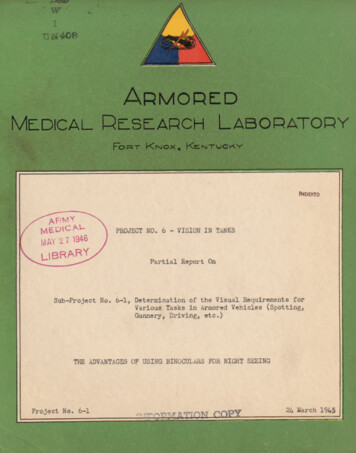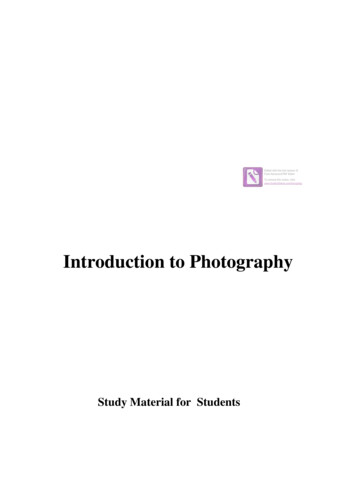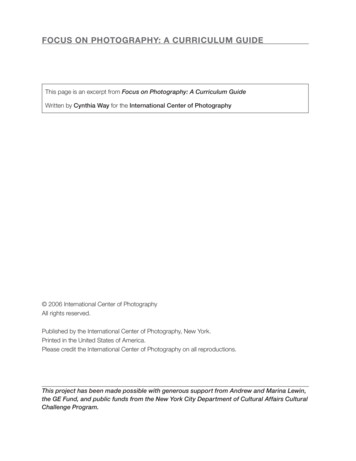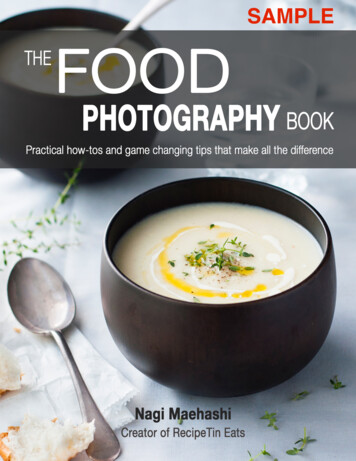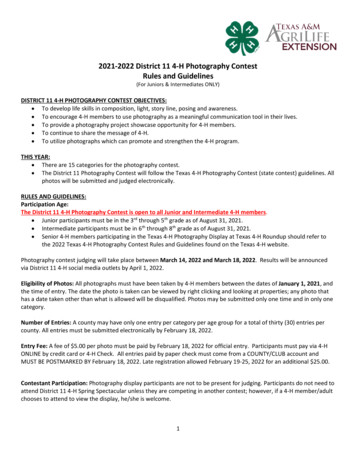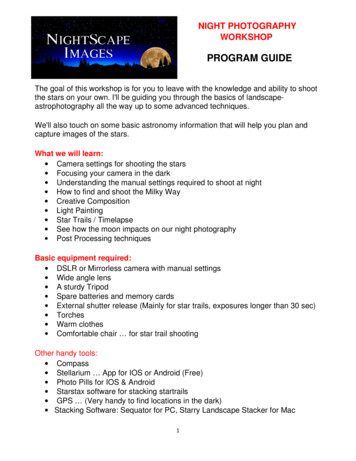
Transcription
NIGHT PHOTOGRAPHYWORKSHOPPROGRAM GUIDEThe goal of this workshop is for you to leave with the knowledge and ability to shootthe stars on your own. I'll be guiding you through the basics of landscapeastrophotography all the way up to some advanced techniques.We'll also touch on some basic astronomy information that will help you plan andcapture images of the stars.What we will learn: Camera settings for shooting the stars Focusing your camera in the dark Understanding the manual settings required to shoot at night How to find and shoot the Milky Way Creative Composition Light Painting Star Trails / Timelapse See how the moon impacts on our night photography Post Processing techniquesBasic equipment required: DSLR or Mirrorless camera with manual settings Wide angle lens A sturdy Tripod Spare batteries and memory cards External shutter release (Mainly for star trails, exposures longer than 30 sec) Torches Warm clothes Comfortable chair for star trail shootingOther handy tools: Compass Stellarium App for IOS or Android (Free) Photo Pills for IOS & Android Starstax software for stacking startrails GPS (Very handy to find locations in the dark) Stacking Software: Sequator for PC, Starry Landscape Stacker for Mac1
Basic requirements for Nightscape shooting:1 A Dark Sky: The number one key element to capturing the night sky, Milky Way,or stars in general is having a dark sky, and I mean the darkest sky possible. Pleasenote, if you can’t see the Milky Way with the naked eye, it will be very hard tocapture it any better on camera.2 Moon Phase: The next equally important step is checking the moon phase. Ifthere is a moon in the sky, the stars will never appear to shine as bright. The moonis much closer than any of the stars seen in the night sky, therefore it will wash themout, and in fact a long exposure at night with even a small moon can look likedaylight. Shooting at New Moon ensures that the moon is not visible in the sky andthat the Milky Way appears as bright as possible.3 Sturdy Tripod: The third crucial item is a sturdy tripod, this is one of the steps thatmany people compromise and therefore sacrifice the quality of their night shots. Bysturdy I don’t mean heavy just solid. A good tripod head is just as important.4 Manual Camera: The 4th and last necessary Item is a camera with manual modefunctionality that shoots in RAW format. This allows the user to have ultimate controlboth when capturing the stars and in the post processing. My preferred camera isthe Nikon Z6, which handles the high ISO and noise induced from night sky shootingflawlessly. I shoot with and highly recommend the Nikon 20mm f1.8S and G serieslenses for many of my star shots. Starting at f/1.8 this is a very sharp and fast lens.My other favourite lenses are the Nikon 14-24 f2.8 & Sigma 35mm f1.4Lens & Camera Advice:If you are looking to get into nightscape photography and are not sure what kind ofcamera or lens to select there are a few points to keep in mind. In my opinion a fullframe camera with a 35mm sensor is the best way to capture the night sky.When talking full frame sensors a few good ones come to mind. Regarding Canonthe 5D Mark III or Mark 4 will work fine as well as the 6D and the new EOS-Rmirrorless. With Nikon the D850, D810, D750 or the D600 series are all really goodas well as the mirrorless Z6 & Z7. Sony have the excellent A7 series. A7iii, A7riiiand A7r4 in particular.Looking at cameras that don’t have a full frame sensor (These are called cropsensor cameras) the Canon 7D, 700D/800D, 70D/80D/90D or the Nikon D5100 –D7500 will do the trick, but a full frame camera makes it easier to capture the MilkyWay and all the stars simply because of it’s superior high iso & low light abilities.2
The latest Fuji mirrorless cameras such as the XT-3 or similar are excellent for nightphotography. Micro 4/3rds cameras such as the Olympus EM-1 and Panasonic G9are ok but you’ll be pushing those smaller sensors to the limit.Lenses:Moving along to lenses there are a few major points that need to be touched on.Having a lens with an aperture of f/2.8 or faster, is pretty much absolutely necessaryfor capturing the Milky Way, for star trails it is not so much a necessity.Recommended Lenses for Milky Way capture:(FULL FRAME CAMERA)(CROP SENSOR CAMERA)CanonNikonCanonNikonCanon 16-35 f2.8Tamron 15-30 f2.8Sigma 14mm f1.8Samyang 14mm f2.4Samyang 14mm f2.8Sigma 20mm f1.4Samyang 24mm f1.4Canon 24-70 f2.8Tokina 16-28 f2.8Sigma 35mm f1.4Canon 50mm f1.8Laowa 15mm f2Tokina 14-20 f2Tokina 11-16 f2.8Tokina 11-20 f2.8Samyang 16mm f2Sigma 18-35 f1.8Samyang 14mm f2.4Samyang 14mm f2.8Nikon 14-24 f2.8Tamron 15-30 f2.8Sigma 14mm f1.8Nikon 20mm f1.8Sigma 20mm f1.4Samyang 14mm f2.4Samyang 14mm f2.8Samyang 24mm f1.4Nikon 24-70 f2.8Tokina 16-28 f2.8Sigma 35mm f1.4Nikon 50mm f1.8Laowa 15mm f2Tokina 14-20 f2Tokina 11-16 f2.8Tokina 11-20 f2.8Samyang 16mm f2Sigma 18-35 f1.8Samyang 14mm f2.4Samyang 14mm f2.8Follow this link for a comprehensive lens guide for other camera ltimate-list-of-best-astrophotography-lenses/Basic camera settings for milky way shooting:I would always shoot with manual settings.IE: Manual Shutter speed, Manual Aperture, Manual ISOChoose the widest suitable aperture available and the shutter speed which is mostappropriate to the lens chosen. (See chart on following page)The ISO setting is determined by the quality of the camera sensor and it’s ability tohandle noise at high ISO. As a rule of thumb most of my nightscape images arebetween 1600 and 6400 ISO. The newer full frame cameras will handle high ISOmuch better than older models or crop sensor cameras.I also select a manual white balance setting of between 3450k – 5000k3
It is possible to achieve great results with auto white balance, but like just abouteverything else with night photography, the camera is easily fooled into selecting thewrong setting. Also when shooting a sequence it makes sense to keep this set.The other major issue facing the night shooter is focussing. Never, I repeat, neverattempt to use auto focus at night. You will be forever frustrated if you do. We willspend a considerable amount of time discussing methods of focussing in the dark.Because the stars appear to move with the rotation of the earth we need to beaware of the maximum shutter speeds we can use with any given lens. If we exceedthese exposure times we will see that the stars leave a trail rather than remain assharp dots.The table below introduces what is known as the 500 rule.This is simply a calculation dividing the focal length of your lens into 500.EG: 500 14 36 (Note: I would usually use the 400 or even 300 rule whenshooting with high megapixel modern cameras to obtain sharp stars)EXPOSURE IN SECONDS BEFORE STARS BEGIN TRAILINGFocal LengthFull Frame CameraCrop Sensor Camera10mm14mm16mm20mm24mm28mm35mm50mm70mm500 Rule - 300 Rulen/a36 sec21 sec31 sec18 sec25 sec15 sec21 sec12 sec18 sec11 sec14 sec8 sec10 sec6 sec7 sec4 sec500 Rule - 300 Rule31 sec19 sec22 sec13 sec20 sec11 sec16 sec10 sec13 sec9 sec11 sec7 sec10 sec5 sec6 sec4 sec4 sec3 secIf you are using a crop sensor camera you will have to divide the full frame result bya factor of 1.5 for Nikon and 1.6 for Canon cameras.EG: 500 14 36 36 1.6 22This diagram illustrates the difference insensor size between a full frame camera andan APS-C crop sensor.4
The full frame camera is able to operate much better at the higher iso’s and low lightshooting required for nightscape photography.The image below illustrates why the crop sensor camera appears to have more“reach” that the full frame model.In reality it’s only showing the centre area that is covered by the full frame model. It’snot actually magnifying the image any more, even though it gives that impression.This diagram helps ussee what effect thecombination of sensorsize and lens focal lengthhas on a milky waylandscape photo.Focusing in the dark:As mentioned earlier, when shooting at night it is very difficult to find accurate focusas the auto focus becomes unreliable. Generally we need to find infinity focus toshoot the milky way, however this is sometimes more difficult than it first seems.Focus Methods to find infinity focus: Turn on live view and focus manually on a bright star or the moon by usingzoom buttons on rear of camera. (This is not zooming the camera lens).When star becomes a sharp point it’s in focus. Focus the camera on a distant mountain or landscape whilst it’s still daylightand make sure the lens doesn’t move before you shoot at night. This methoddoes not work with Focus by Wire lenses. (Usually mirrorless lenses) Shine a light or torch on a fence post at an appropriate distance once it’s darkoutside (this distance varies depending on focal length of lens see Depth ofField Calculator later) and repeat steps explained previously using live viewscreen.5
Focusing is probably one of the single most difficult things to do at night and it takesquite some time to master.Generally speaking when taking landscape photos we want everything to be sharplyin focus. The challenge is to balance the focus of foreground objects with the distantstars sound easy but it isn’t.This is where a Depth of Field Calculator comes in handy.The following link is an example of a depth of field calculator. http://www.dofmaster.com/dofjs.htmlPhotopills is another great leWhen shooting with a wide angle lens it’s easier to get everything in focus once youcan find infinity. The more you zoom in, the harder it becomes.An example of the rear screen inlive view mode.When you zoom in using theplus and minus buttons on theleft, the red centre rectanglebecomes larger helping you seethe correct focus.Be sure to adjust the camera tomanual focus mode.Many lenses have infinitymarkings on them but it is myexperience that these are notaccurate.Out of all my lenses I have onlyone that when lined up perfectlyat infinity it actually is infinity.My advice is to always check thefine tuning of any lens.6
How to find the Milky Way:This is where the rubber hits the road. You’ve packed all your gear, you drive outinto the dark sky to a country location, you look up and see . no milky way.Having a basic understanding of astronomy certainly helps us with nightscapephotography but those of us who have no idea about astronomy need help.Although there is usually some portion of the milky way visible all year round, wehave to understand that the best images are those that focus on what is known asthe Milky Way Core.In both the Northern & Southern Hemispheres we find the core, which is the thickestand brightest part of the milky way in the constellations of Scorpio and Sagittarius.The image above left was taken during February at 12.27 am facing south. Theimage on the right was also taken in February but at 4.25am facing south east.You will notice that due to the earth’s rotation the brighter and thicker part of themilky way which wasn’t visible in the first image has risen above the horizon and isplaced beautifully behind the tree. (Southern Hemisphere images)7
To put this into perspective the image to the left above was taken during July atabout 11pm facing almost directly overhead, whereas the image above right wastaken during September at about midnight facing south west.The milky way is constantly on the move and unless we know where it will be whenwe go out to shoot at night we run the risk of being constantly disappointed.Added to this is the fact that the milky way core is not visible at all during Novemberthrough January.Thankfully there is an amazing piece of software to help us . Stellarium.Stellarium is great software available for desktop and mobiles and what it does isamazing. For any given day, month and year it will tell us where everything islocated in the day or night sky. It gives moon phases and shows where planets areas well. It also shows altitude, elevation and compass direction to make planningwhere and when to shoot a breeze.www.stellarium.org Also available from app stores, Apple and Android.This is a screenshot of the Stellarium interface, and whilst it may appear a bit daunting at first,believe me it is a life saver once you get used to it.Equipped with Stellarium and a good compass, it becomes simply a matter of deciding where toshoot.8
Creative Composition:Ok now we get to a challenging yet most rewarding aspect of nightscapephotography.A question I constantly have to ask myself. What makes a great image ?Is it the light, or perhaps the angle of view maybe it’s the subject matter .perhaps nailing the exposure settings.All of those responses are certainly true and contribute to a great image, but there isone thing that must be present when attempting to get a great nightscape image.The ability to see something in our mind before we actually see anything on the rearscreen of our camera . we need imagination, we need to learn to pre-visualize ourwork.We’ve discussed many aspects already regarding the steps required to simplyprepare ourselves to shoot at night, but all the technical ability in the world won’tproduce a master shot . It takes just as much energy to think through the nightphotography process before we leave home as it does once we arrive on site toshoot.In fact I’d say that there is considerably more time spent during daylight hoursseeking shooting locations and researching where the milky way is likely to be afterdark than anything else. That’s why we need to develop our imagination, foster akeen sense of what the scene could look like without daylight, or perhaps how itmight look when light painted.Whichever way you look at it, photography is art. People who love photography aregenuine artists. The problem is that because we have to cram our heads full of somuch technical stuff the creative juices can run a little thin. When we go out to shootwhat is going through our minds ? I can guarantee, especially with nightphotography that a large proportion of our thinking and preparation is going into thegear required to get the shot, making sure the batteries are charged and a thousandother details.When we get to the point of preparing the gear in auto pilot mode and begin toimagine the type of shots we can get when we go out to shoot and give ourselvesspace to create, well that’s when the brilliance happens.So in summary, the process of shooting nightscape images goes something likethis. Learn how to operate your camera efficiently in manual modePractice focussing your lenses and study the results on your computerStudy the techniques until they become second natureGet a basic understanding of astronomySpend lots of time scouting locations in the daylight hoursLet your imagination run wild and don’t limit yourself9
Composition in any form of photography is vital, and even more so when shootingthe nightscape image.I’d like to draw attention to an obvious but often overlooked aspect of nightscapeshooting a lack of light. Now before you start laughing at me and ask what thathas to do with creative composition, I want you to consider the two images above.On the left we see a lovely shot of the milky way rising above a country landscape. Itcould be anywhere and it’s not until we see the exact same shot above right but withthe addition of a person (me) shining the light into the sky that we get anunderstanding of what the scene really looks like with the simple addition of lightwe are much more drawn into the image.The sky is exactly the same but the detail in the foreground gives the image a senseof depth and perspective.The above images show exactly the same thing. The left image exhibits a lovelysilhouette and many times that can be quite stunning, but at other times the additionof detail in the foreground brings the image to life as represented in the image onthe right above.All of this brings us to ask the question: How do I add this lighting to my images ?10
Light Painting:Ok, this is potentially a very complex subject but I will keep it to the basics for themoment. There are many ways to add light into a night landscape image includingusing hand held light sources such as torches or flashes, making use of ambientlight such as street lighting, using moonlight to help light a foreground and alsotaking advantage of incidental light sources such as passing traffic.I’d like us to focus on light painting with hand held sources, usually torches. Most ofthe nightscape images I take use this method in one way or another. Asdemonstrated above there are many times where adding a small amount of lightbrings a remarkable lift to our night images.Both of the above images were lit using a basic led torch. Using a gentle paintingmotion being careful not to create “hot spots” in the image you can easily introducebeautiful texture, form and shape. By keeping the light low and off to an angle wecreate lovely shadows, especially on 3D objects such as cars and buildings.Light painting requires a fair amount of practice to get right. Because we generallyset very high ISO’s on our cameras when shooting at night, it’s really easy tooverexpose our image by putting too much light into it.You can see how this night photoof a canola crop quicklyoverexposes when light paintedwith a small hand held torch.This is a 20 second exposure at ahigh ISO of 2500.I had to wave my light over thecrop for only a few seconds tocorrectly expose the scene.11
So as you can see, light painting with a simple led light can introduce an enormousamount of creativity to our night images. Light painting is exactly that paintingwith light. Don’t ever let anyone tell you that photography isn’t art !!!The image to the left shows some of thelighting devices I commonly use to lightpaint my photos.From left to right:Z96 video light Dimmable1000 lm LED torch zoomable450 lm LED torch zoomable300 lm LED torch zoomableBecause most LED lights are balanced to more of a blue colour I like to usecoloured gels to add some yellow into the mix. Added to this I usually set my whitebalance in camera to somewhere between 3800k & 4500k. This has the effect ofexposing a more to the blue end of the colour spectrum and my reason for doing thisis because I like that colour balance. Not everyone will agree and that’s quite ok.During post processing of raw image files it’s quite easy to adjust the white balanceof the image to bring out the warmer yellow tones so it makes sense to give the lightsource a bit more yellow to start with.Just to illustrate my point, check out the two images below. The left image is astandard led torch whilst the right image has a ½ cto filter (Colour Temp Orange).White balance on both is set to 3450k.12
As we delve more into the creative side of taking pictures at night we quickly realizethat there is no limit to the possibilities when it comes to lighting our shots.There are times when we may want to blend multiple images to create for example apanorama or simulate a high dynamic range image (HDR). This involves using morethan one shot to create a photograph. I have used as many as 16 images to createone single photograph a few times and whilst this in itself is a challenging scenarioespecially at night, the lighting of such an image becomes critical.The above picture is a combination of 5 separate exposures. One for the milky waysky in the background, and four more using light painting techniques to creativelylight the car and surrounds from different angles to best bring the image to life.These 5 images are the rawshots blended to create thesingle image shown above.13
One further complication with a blended image as per the one shown on theprevious page is focus. The more you consider the image the more you realize thatthe distant milky way will obviously require infinity focus on the lens, whereas the oldcar in the foreground is only a matter of 2 or 3 metres away from the tripod mountedcamera. This adds another element in the never ending obstacles placed before thecreative photographer seeking to create a nightscape masterpiece.Creative use of light painting as shown above will transform our nightscape imagesfrom ok to awe inspiring but as you can imagine this is no easy task. It takes lots ofpractice.So in summary, here is my light painting guide: Make use of standard LED lighting devicesConsider putting on gels to balance out the colour of LED’sPractice using gentle sweeping strokes. Paint the light.Be careful not to overexpose the shotNever light your subjects from directly behind the cameraUse angles to create shadow and textureLight from low down, especially over grass and shrubsLook for opportunities to make use of “backlighting” as per images aboveIt is possible to light distant objects such as mountains with stronger lightsWe started this section discussing creative composition and so I’d like to concludeby saying that all the rules designed for daylight photography remain at night.Things such as the rule of thirds, creating leading lines, drawing attention to singleobjects etc are what make a great image always have and always will.At night all of this becomes harder to achieve but much more satisfying when youdo. As I keep saying, photography is an art form and the more we practice the betterwe become.We have one more dynamic subject to consider in our night photography journey.14
Star Trails:We may well have left our best topic till near last. Star trails can be fairly ordinary orquite stunning. What makes the difference .? Well, not surprisingly just about all ofthe things we have discussed previously apply to taking great star trail images.The above image is a compilation of 10 x 3 minute exposures. 14mm lens at f3.5with a relatively low ISO of 640. White balance was about 3800kWhen I first started taking pictures of the night sky as a teenager, all that wasrealistically possible were star trails. Back then using film cameras you would leavethe shutter open for hours and let the rotation of the earth give the effect of streakingor trailing the stars.This is still possible with modern digital cameras but I find it much more effective tocombine, or “stack” multiple shorter length images. It is quite simple to do this insoftware such as photoshop and there is a free piece of software called Starstaxwhich is available for both windows and mac.Check this taX.htmlThe first question many of you will be asking is how do I keep the shutter open for 3minutes as most cameras have a maximum of 30 seconds as shutter speeds.There are a number of methods but the best and easiest to use is an intervalometer.15
This is an intervalometer. Itenables the user to set any shutterspeed by selecting the bulb modeon the camera.As well as shutter speed it givesus the option to take any numberof shots at any given shutterspeed one after the other.This is the same device usedcommonly to capture timelapsesequences.It’s a simple matter of setting thenumber of shots required, theshutter speed and the intervalbetween each shot.So as we discovered previously, once we set the device to operate the camera tocapture the images the responsibility is on us to correctly focus and compose theshot.All of the techniques such as light painting are used whilst capturing star trails.Sometimes the foreground can be lit and captured in the first 3 minute exposure andduring the other remaining exposures you can go relax and have a cup of tea. Asthe majority of the shots are capturing the stars, there isn’t really much that you cando except wait.Old Truck Star Trails10 x 3 minute exposuresat f2.8 ISO 800 (Stars)Then blended with 3 moreexposures focussed onthe truck at f425 seconds ISO 800.One of my favouriteimages comes to lifesimply because of the timeI spent lighting the truckand grass in theforeground.16
I find that the best star trails are captured facing south in the Southern Hemisphereand north in the Norther Hemisphere as the stars rotate around that part of the sky.This gives us a full circle of motion which is somehow pleasing to the eye. It alsomeans we can have shorter length shots and still see the motion quite clearly.Star Trails in summary: As with all nightscape photography . use a steady tripodUse an intervalometer to automate the capture of star trailsGenerally use wide angle lenses to capture more skyUse light painting to give the foreground some perspectiveLook for interesting subjects to compose in the foregroundRelax and enjoy the view as the camera does it’s stuff !!!!I haven’t spoken a lot about post processing as I feel this requires more hands ondiscussion. Everybody has an opinion as to the amount of image manipulationrequired to obtain that perfect shot.For what it’s worth I do the vast majority of my nightscape photo editing in AdobeLightroom with a lesser amount of complimentary work in Adobe Photoshop. Iusually use this combination to process my star trails.As stated you can use Starstax for star trails and a free windows program calledMicrosoft ICE for panoramas, although now that’s an added feature in LightroomCreative Cloud I tend to use that and Photoshop more.Here is a screenshot showing the Lightroom interface. You will notice the variousadjustments made to the image on the RH side panel.17
This is before and after of the same shot. You can clearly see how the simple adjustmentsmade to the image reveal the detail, especially in the milky way. This proves that the detailis captured in camera, but especially in raw we need to tweak the settings to bring it out.I did mention earlier that we should always capture our nightscape images in raw format.This becomes very apparent when we begin post processing as the raw image retains allthe necessary information to make whatever adjustments we need to do possible. If wecaptured all our images in jpeg format we have already lost significant data whichcompromises our final results.The images shown below of the old ute highlight the differences possible when delving intothe raw data retained during capture in that format.18
In the image below I’d like to draw our attention to the sliders on the RH side of theLightroom panel. During long exposures at high ISO’s you will notice quite a lot ofdigital noise is generated. This means we have to introduce a level of noisereduction. Lightroom noise reduction is pretty good at doing just that but be awarethat there is always a trade off when getting rid of noise. A lot of noise is reduced butat the expense of the fainter stars as the software sees these as noisy spots.One other aspect which relates more particularly to wide angle lenses is distortion.When shooting very wide you will often notice vertical lines lean into the middle ofthe shot. This is a normal characteristic of any wide angle lens but it can appearquite off putting at firstLightroom deals with this very effectively in it’s lens correction panel. There arenumerous adjustments possible there but remember that whenever makingadjustments to the lens correction you will often lose some ‘real estate” on the finalimage. So be warned, if you are shooting a subject that will ultimately need a lot oflens correction to fix vertical straight lines, then don’t go too close to the edges ofthe frame as these will inevitably be cropped out.There are numerous instruction manuals and videos available for both Lightroomand Photoshop which address all of these techniques in greater detail than we canget into here. Take the time to study some of these as like everything else, practicemakes perfect.19
Panoramas:Milky Way Panoramas are certainly possible with lots of wonderful software options.I often use Lightroom CC for this but Photoshop, PTgui, Microsoft ICE, Hugin,Autopano and others are really good options.The above panorama image was created using 21 images. Three horizontal rows of7 shots with about a 40 - 50 % overlap between the images.The equipment I used for the above shot was Nikon D750 & Nikon 20mm f1.8 @f2.8 aperture, 20 second shutter speed and iso2500 for each shot.It’s important to keep the camera level when shooting as this greatly affects theoutcome. Some prefer to use a dedicated panorama tilt head for this type ofshooting although I’ve never used one myself.The shot below is only 3 images with the same camera/lens & settings as above.20
Final thoughts:I am of the opinion that photography is an art form and as such the final outcome ofan image rests in the imagination of the photographer. I also believe that mostpeople want to see a nightscape image the way that they imagine it should look.When we first begin taking images of the stars at night we realise that the cameracan see a whole lot more than we ever could. That, coupled with the power of postprocessing software which has the ability to enhance and bring out the colour andbeauty of the night sky well the sky is literally the limit.When we tap into the techniques discussed in this manual and begin to see what wecan achieve I guarantee we will become much more accomplished photographers inevery other aspect of the craft. Night photography is immeasurably more complexthat it’s daylight cousin, yet they share the same chemistry, the same mysticalromance that draws us more into the journey of making beautiful pictures.And never forget to savour the moment whenever you experience the awe inspiringmilky way on a dark moonless night. The night sky is art in itself, we as nightscapephotographers are privileged to bear witness to it.21
General information:Equipment used to capture & process all the images used in this manual: Nikon D750, Nikon D610 Nikon 14-24 f2.8, Nikon 20mm f1.8G, Sigma 35mm f1.4, Nikon 50mm f1.8,Samyang 14mm f2.8, Samyang 24mm f1.4 Manfrotto tripod with pan/tilt head Inexpensive Intervalometer Ebay not brand name Simple L
Light Painting Star Trails / Timelapse See how the moon impacts on our night photography Post Processing techniques Basic equipment required: DSLR or Mirrorless camera with manual settings Wide angle lens


